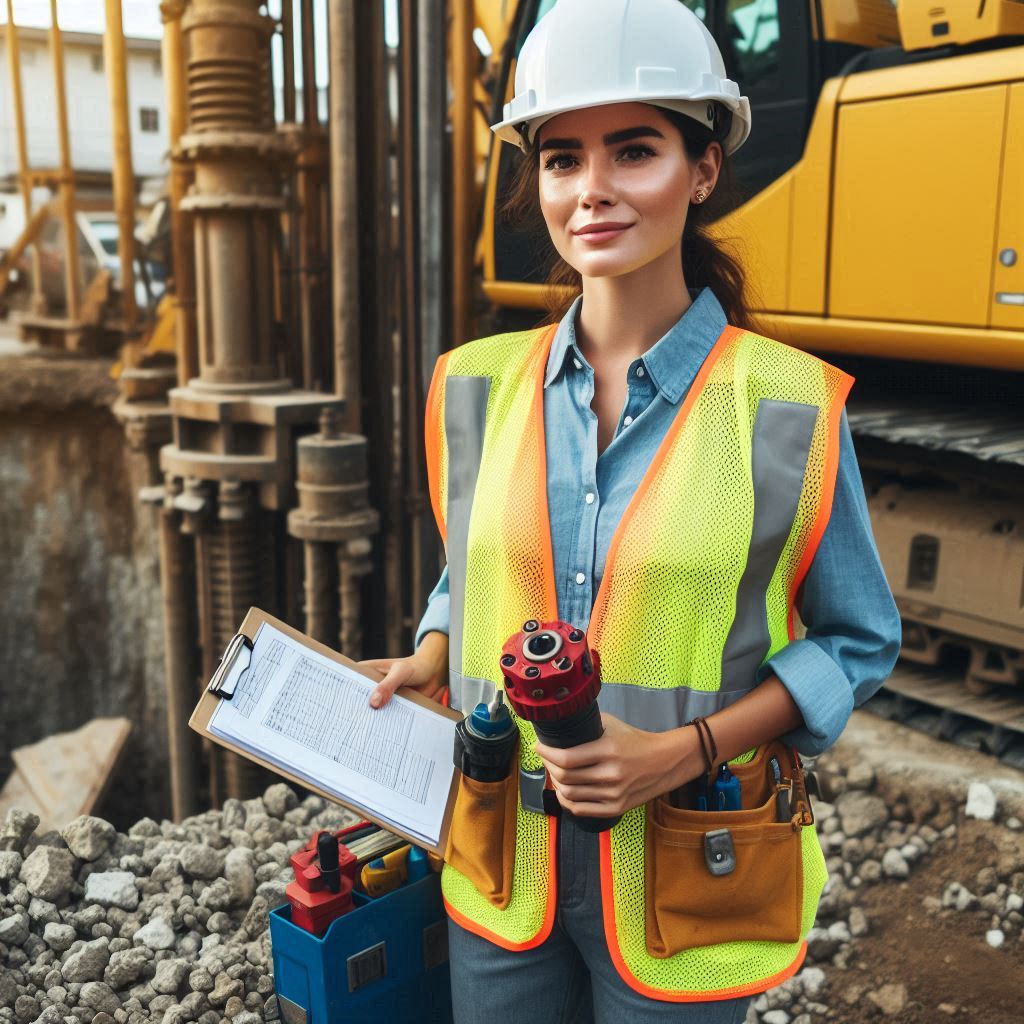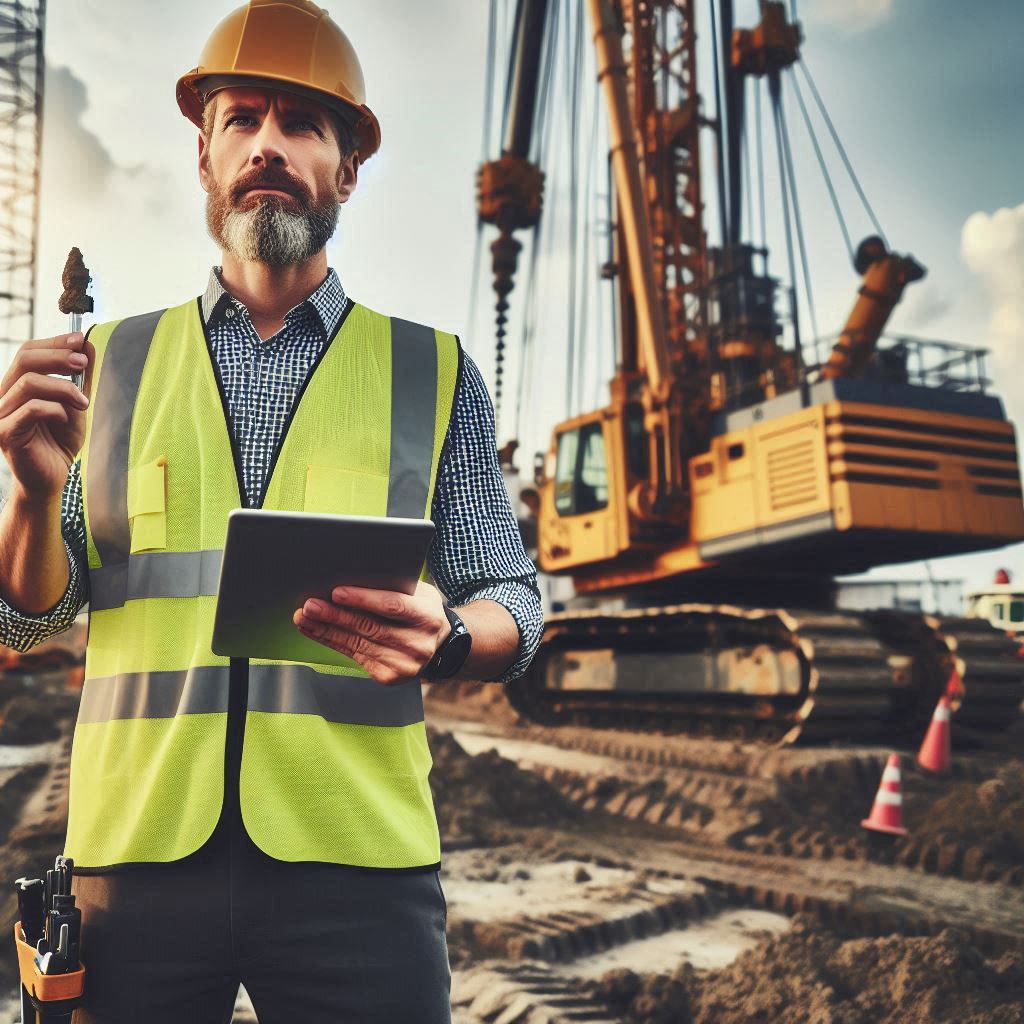Introduction
Geotechnical engineering focuses on understanding and utilizing earth materials for safe and stable construction.
This discipline involves analyzing soil, rock, and groundwater to ensure structures are built on solid foundations.
Engineers in this field assess site conditions to predict and mitigate potential risks such as landslides, liquefaction, and settlement.
They play a crucial role in designing foundations for buildings, bridges, dams, and tunnels.
Their work ensures that infrastructure can withstand environmental stresses and loads.
Geotechnical engineers use various techniques, including soil testing, boring, and modeling, to gather essential data for their designs.
By studying subsurface conditions, they help prevent structural failures and enhance the longevity of projects.
Staying updated on future trends in geotechnical engineering is essential for several reasons.
Emerging technologies offer new ways to analyze and interpret soil and rock properties.
Advanced sensors and monitoring systems provide real-time data, enhancing project accuracy and safety.
Innovations in construction techniques and materials lead to more efficient and cost-effective solutions.
Sustainable practices are becoming increasingly important, helping reduce the environmental impact of engineering projects.
Adopting new methods and technologies improves the ability to address modern challenges, such as climate change and urbanization.
Continuous learning about these trends helps engineers stay competitive and effective in their roles.
It also allows for the integration of cutting-edge solutions into projects, leading to better outcomes.
Engaging with future trends ensures engineers can apply the latest knowledge and innovations, driving progress in the field.
Embracing these developments supports both personal career growth and the advancement of geotechnical engineering as a whole.
Increased use of advanced technologies
The increased use of advanced technologies is reshaping the field of geotechnical engineering.
Innovations like drones, artificial intelligence (AI), and advanced materials are transforming how engineers approach site analysis and design.
These technologies enhance accuracy, efficiency, and safety in geotechnical projects.
Drones are now a common tool for site surveys and data collection.
They provide high-resolution images and detailed 3D models of terrains.
Drones offer a quick and safe way to capture data from difficult or hazardous locations.
They reduce the need for traditional surveying methods, which can be time-consuming and labor-intensive.
Drones also enable real-time monitoring of construction sites, allowing engineers to track progress and detect issues promptly.
Use of Drones for Site Surveys and Data Collection
The use of drones for site surveys and data collection is revolutionizing geotechnical engineering.
Drones offer a fast and efficient method for gathering detailed site information.
Engineers can deploy drones to capture high-resolution images and videos of the terrain.
These images help create accurate topographical maps and 3D models of the site.
Drones can access hard-to-reach or dangerous areas without risking human safety.
They provide a comprehensive view of large sites, reducing the time needed for traditional surveys.
Equipped with various sensors, drones can collect data on soil composition, moisture levels, and temperature.
This capability allows for precise and extensive site assessments.
Engineers use drone-collected data to identify potential geotechnical issues early.
Drones can monitor ongoing construction projects, ensuring adherence to design specifications.
They can also detect changes in site conditions, like erosion or landslides, in real-time.
This real-time monitoring helps engineers make informed decisions promptly.
Using drones reduces the costs associated with manual surveying.
It also minimizes the need for heavy equipment and extensive labor.
Drones offer a more environmentally friendly option for site surveys, as they cause minimal disturbance to the environment.
The technology continues to advance, making drones increasingly integral to geotechnical engineering.
Implementing Artificial Intelligence for Data Analysis
Artificial intelligence (AI) is transforming data analysis in geotechnical engineering.
AI algorithms can process vast amounts of data quickly and accurately.
Engineers use AI to analyze soil properties, predict ground behavior, and assess risks.
Machine learning models can identify patterns and correlations in geotechnical data that might be missed by humans.
AI enhances the accuracy of site assessments and predictions.
Engineers can use AI to forecast the stability of slopes and the performance of foundations.
AI-driven models simulate different scenarios, helping engineers design safer and more efficient structures.
These models improve risk management and decision-making processes.
AI can integrate data from various sources, providing a comprehensive analysis.
It processes data from drones, sensors, and historical records to deliver detailed insights.
Engineers use AI to automate routine tasks, freeing up time for more complex analyses.
This automation increases productivity and reduces human error.
Incorporating AI into geotechnical engineering improves project outcomes and safety.
AI tools help engineers develop better solutions for challenging geotechnical problems.
They optimize designs and enhance construction methods, ensuring structures are resilient and sustainable.
AI also supports continuous learning and improvement in geotechnical practices.
AI-driven data analysis contributes to the advancement of geotechnical engineering.
Engineers can leverage AI to explore new materials and techniques.
This exploration leads to innovative solutions and improved construction practices.
AI fosters collaboration by providing a common platform for data sharing and analysis.
Read: Decoding the Ethics & Responsibilities of US Civil Engineers
Sustainability and Environmental Considerations
When we talk about the future trends in geotechnical engineering, one of the key aspects that will continue to evolve is sustainability and environmental considerations.
With a growing focus on green infrastructure and eco-friendly designs, geotechnical engineers are now taking into account the impact of their projects on the environment and working towards more sustainable solutions.
The future of geotechnical engineering increasingly focuses on green infrastructure and eco-friendly designs.
Sustainable practices are becoming essential in construction.
Engineers now prioritize minimizing environmental impact while enhancing structural performance.
Green infrastructure integrates natural systems into engineering projects, reducing reliance on artificial solutions.
One major trend is the use of recycled materials in construction.
Engineers are exploring ways to repurpose materials like crushed concrete and reclaimed asphalt.
This approach not only reduces waste but also lowers costs.
Another innovation is the design of permeable pavements that allow water to infiltrate, reducing runoff and promoting groundwater recharge.
Green roofs and living walls are gaining popularity in urban environments.
These designs help insulate buildings, improve air quality, and support biodiversity.
Engineers are implementing these features to enhance urban resilience and reduce the heat island effect.
By incorporating vegetation into building designs, they also create more aesthetically pleasing environments.
Focus on Green Infrastructure and Eco-friendly Designs
One of the major trends in geotechnical engineering is the shift towards green infrastructure and eco-friendly designs.
This involves designing projects that have a minimal environmental impact and are in harmony with nature.
Engineers are increasingly looking for ways to incorporate environmentally friendly materials and construction techniques into their projects.
- Use of permeable pavements to reduce stormwater runoff and allow for groundwater recharge.
- Incorporation of green roofs and walls to improve air quality and reduce urban heat island effect.
- Implementation of sustainable drainage systems to manage stormwater in a more natural way.
- Designing projects that promote biodiversity and habitat restoration.
- Utilizing recycled materials in construction to reduce the demand for new resources.
Incorporating Renewable Energy Sources in Geotechnical Projects
Another important trend in geotechnical engineering is the integration of renewable energy sources into projects.
This not only helps reduce the carbon footprint of construction activities but also provides sustainable energy solutions for the future.
Geotechnical engineers are exploring various ways to incorporate renewable energy technologies into their projects.
Sustainable soil management practices are also becoming crucial.
Engineers now use techniques such as soil stabilization and bioremediation to improve soil health and functionality.
These methods help mitigate soil erosion and contamination, promoting long-term land sustainability.
Techniques like soil nailing and ground improvement also contribute to more eco-friendly designs.
Another significant trend is the integration of renewable energy sources in geotechnical projects.
Solar panels and wind turbines are increasingly being incorporated into infrastructure designs.
Engineers are exploring ways to combine these technologies with traditional structures to enhance energy efficiency.
- Installation of geothermal heat exchange systems to provide heating and cooling for buildings.
- Integration of solar panels into retaining walls and other structures to generate electricity.
- Utilization of wind turbines in geotechnical projects to harness wind energy.
- Exploration of tidal and wave energy technologies for coastal geotechnical projects.
- Implementation of micro-hydropower systems in geotechnical structures near water bodies.
Read: 5 Essential Software Tools Every US Architect Uses.
Emphasis on Risk Management and Resilience
Advanced materials and innovative construction techniques play a significant role in enhancing structural resilience.
Engineers use high-strength materials and flexible design approaches to withstand extreme forces.
For instance, aerodynamic building shapes and reinforced concrete can reduce wind loads and improve stability during storms.
Effective stormwater management is another critical aspect.
Engineers design drainage systems to handle excessive rainfall and prevent flooding.
Techniques like green roofs, permeable pavements, and improved drainage systems help manage stormwater efficiently, reducing flood risks and maintaining structural integrity.
Energy efficiency also contributes to resilience.
Structures designed with high thermal performance can better handle extreme temperatures, whether it‘s heatwaves or cold spells.
Insulated walls, energy-efficient windows, and climate-adaptive design features help maintain stable indoor conditions, enhancing comfort and reducing energy costs.
Geotechnical engineering is increasingly focusing on risk management and resilience in response to evolving environmental challenges.
Utilizing Predictive Modeling for Assessing Potential Hazards
Predictive modeling is transforming how engineers assess potential hazards in geotechnical engineering.
This advanced technology helps forecast various environmental and structural risks.
By using historical data and real-time inputs, predictive models offer valuable insights into future conditions.
These models enhance the ability to anticipate and mitigate potential hazards before they become critical issues.
Engineers input data such as soil properties, weather patterns, and seismic activity into predictive models.
The models then simulate different scenarios, providing a range of possible outcomes.
This approach helps identify potential weaknesses in designs and areas at high risk of failure.
For example, models can predict how soil might behave under various loading conditions or how a structure might respond to seismic activity.
- Predictive modeling techniques are being used to anticipate potential hazards and mitigate risks proactively.
- This approach enables engineers to identify vulnerabilities and implement measures to enhance structural stability.
- By analyzing data and trends, geotechnical professionals can predict potential failures and prevent catastrophic consequences.
- Geotechnical engineers are embracing technology to develop advanced models that simulate various scenarios and assess potential risks.
Designing Structures to Withstand Extreme Weather Events
- With the increasing frequency of extreme weather events, geotechnical engineers are designing structures to withstand such conditions.
- Structural designs now incorporate features that enhance resilience and minimize the impact of natural disasters.
- Geotechnical engineering principles are being integrated into the design process to ensure structures can withstand seismic activities, floods, and hurricanes.
- Engineers are employing innovative materials and construction techniques to enhance the resilience of geotechnical structures.
Designing structures to withstand extreme weather events is becoming increasingly critical.
As climate change intensifies, engineers must consider more severe weather conditions in their designs.
This involves creating structures that can endure high winds, heavy rainfall, and temperature extremes.
Engineers are incorporating advanced materials and construction techniques to enhance structural resilience.
For example, materials with high strength and flexibility can withstand strong winds and seismic activity.
Innovative design methods, such as aerodynamic shapes and reinforced structures, help reduce wind loads and improve stability.
Stormwater management is another key aspect of designing for extreme weather.
Engineers are implementing advanced drainage systems and flood prevention measures to handle heavy rainfall.
Techniques like green infrastructure, including permeable pavements and rain gardens, help manage stormwater and reduce flooding risks.
Read: Comparison: Architecture Styles across American Regions.

Integration of Building Information Modeling (BIM)
In the realm of geotechnical engineering, the integration of Building Information Modeling (BIM) is revolutionizing the way projects are planned, designed, and executed.
BIM offers a comprehensive digital representation of physical and functional characteristics of a project, allowing for efficient collaboration and coordination among various stakeholders.
Building Information Modeling (BIM) is transforming the field of geotechnical engineering.
BIM integrates digital representations of physical and functional characteristics into a single model.
Engineers use BIM to create comprehensive, detailed 3D models of geotechnical projects.
These models include data on soil properties, foundation design, and structural elements.
By integrating various data sources, BIM enhances accuracy and consistency throughout the project lifecycle.
BIM significantly improves communication among project stakeholders.
It provides a shared platform where engineers, architects, and contractors can collaborate.
This centralized model ensures that everyone works from the same set of data.
It reduces misunderstandings and miscommunications that can lead to costly errors.
Real-time updates and changes in the BIM model are visible to all team members.
This transparency helps align efforts and maintain project consistency.
Streamlining communication and collaboration among project stakeholders
BIM significantly improves communication among project stakeholders.
It provides a shared platform where engineers, architects, and contractors can collaborate.
This centralized model ensures that everyone works from the same set of data.
It reduces misunderstandings and miscommunications that can lead to costly errors.
Real-time updates and changes in the BIM model are visible to all team members.
This transparency helps align efforts and maintain project consistency.
Additionally, BIM facilitates better decision-making.
Stakeholders can visualize potential issues and address them early in the design phase.
They can simulate various scenarios to evaluate their impact before actual construction begins.
This proactive approach minimizes conflicts and rework during construction.
- One of the key advantages of incorporating BIM in geotechnical engineering is the streamlined communication it facilitates among project
stakeholders. - Through BIM, engineers, geologists, contractors, and other team members can access and share project information in real-time, leading to better decision-making and problem-solving.
- By providing a centralized platform for data exchange, BIM eliminates the silos that often hinder effective communication in traditional project delivery methods.
- This enhanced collaboration not only improves project outcomes but also reduces the likelihood of errors and conflicts that can arise due to miscommunication.
Enhancing project visualization and coordination
BIM enhances project visualization by providing a detailed 3D view of the project.
Engineers and stakeholders can interact with the model to understand complex design elements.
This visualization helps identify potential challenges and design flaws before construction starts.
It also allows for accurate planning of construction sequences and methods.
Coordination among various disciplines improves with BIM.
The model integrates data from different engineering specialties, including structural, civil, and geotechnical.
This integration helps ensure that all components fit together seamlessly.
Clash detection tools within BIM identify conflicts between different elements of the design.
This early detection of issues allows for timely adjustments, reducing delays and costs.
- BIM offers advanced visualization capabilities that allow project stakeholders to better understand and visualize geotechnical challenges and solutions.
- By creating 3D models of subsurface conditions, BIM enables engineers to simulate various scenarios and evaluate the impact of different design options on the project.
- Furthermore, BIM aids in the coordination of geotechnical data with other disciplines, such as structural, mechanical, and electrical engineering, ensuring seamless integration of all project components.
- Through clash detection and coordination tools, BIM helps identify and resolve conflicts early in the design phase, minimizing costly rework during construction.
Read: The Role of NCARB in US Architecture Licensing.
Continued development of ground improvement techniques
Geotechnical engineering is evolving rapidly, driven by emerging technologies and innovative practices.
Key future trends include the integration of Building Information Modeling (BIM), advanced soil analysis techniques, sustainable construction practices, and the continued development of ground improvement techniques.
BIM enhances project accuracy, collaboration, and visualization, leading to better decision-making and fewer errors.
By integrating data from various sources into a unified model, BIM improves consistency and efficiency throughout the project lifecycle.
Advanced soil analysis techniques provide more precise data, improving the reliability of geotechnical designs.
These methods allow for a deeper understanding of soil properties and behavior, enabling engineers to create more robust and stable foundations.
Innovations such as remote sensing and geophysical methods offer new ways to gather and interpret data, enhancing the accuracy of subsurface investigations.
These advancements aim to enhance the stability, safety, and efficiency of geotechnical projects.
Engineers are continually exploring new methods to address soil and ground challenges.
Transform Your Career Today
Unlock a personalized career strategy that drives real results. Get tailored advice and a roadmap designed just for you.
Start NowGround Improvement Techniques
Are evolving to tackle diverse geotechnical problems.
Techniques like deep soil mixing and dynamic compaction are becoming more refined.
Deep soil mixing blends soil with stabilizing agents to increase strength and reduce settlement.
Dynamic compaction uses heavy weights to compact soil, improving its load-bearing capacity.
Engineers are also developing innovative ground improvement methods, such as electrokinetic stabilization, which uses electrical currents to strengthen soils.
Advancements in Soil Stabilization Methods
Focus on enhancing the properties of soil to make it more stable.
Traditional methods like lime and cement stabilization are being optimized for better performance.
Newer techniques involve the use of biodegradable polymers and geopolymers.
These materials are eco-friendly and offer improved soil strength and durability.
Researchers are also investigating the use of nanomaterials to enhance soil properties at a microscopic level.
Innovations in Ground Reinforcement Technologies
Focus on enhancing the properties of soil to make it more stable.
Traditional methods like lime and cement stabilization are being optimized for better performance
Newer techniques involve the use of biodegradable polymers and geopolymers.
These materials are eco-friendly and offer improved soil strength and durability.
Researchers are also investigating the use of nanomaterials to enhance soil properties at a microscopic level
Geosynthetics
Are becoming more advanced, offering new solutions for ground reinforcement.
These materials, including geotextiles and geomembranes, are used to improve soil stability and drainage.
Recent innovations in geosynthetics focus on increasing their strength, durability, and environmental compatibility.
Engineers use geosynthetics in a variety of applications, from erosion control to slope stabilization.
Bioengineering Techniques
Are gaining traction in ground improvement.
These methods use vegetation and natural processes to stabilize soil and prevent erosion.
Techniques like planting deep-rooted grasses and trees are increasingly employed to enhance soil structure.
Bioengineering offers a sustainable approach to ground stabilization, combining engineering with ecological principles.
Smart Technologies
Are making their way into ground improvement and reinforcement.
Sensors and monitoring systems provide real-time data on soil conditions and structural performance.
Engineers use this data to make informed decisions and adapt strategies as needed.
Smart technologies help predict potential issues and optimize ground improvement techniques.
Sustainable Practices
Are becoming a key focus in geotechnical engineering.
Engineers are emphasizing eco-friendly materials and methods to reduce the environmental impact of ground improvement projects.
This includes using recycled materials and minimizing waste in stabilization and reinforcement processes.
The future of geotechnical engineering is shaped by continued advancements in ground improvement techniques, soil stabilization methods, and ground reinforcement technologies.
Engineers are exploring innovative solutions to address complex challenges and improve the stability and safety of structures.
These developments promise to enhance the effectiveness of geotechnical engineering and contribute to more sustainable construction practices.
You Might Also Like: Cybersecurity Analyst: Entry-Level Job Requirements
Shift towards performance-based design practices
The geotechnical engineering field is experiencing a shift towards performance-based design practices.
Engineers now focus on evaluating structures based on actual performance.
This approach moves beyond traditional theoretical calculations to consider real-world conditions.
Performance-based design aims to improve both design efficiency and project outcomes.
Traditionally, geotechnical design relied heavily on theoretical models and assumptions.
Engineers based designs on average soil properties and standard conditions.
However, these methods often fail to account for site-specific variables and complex interactions.
Performance-based design addresses these limitations by integrating real-time data and actual performance metrics.
Engineers use advanced monitoring technologies to gather data during construction and throughout a structure’s lifecycle.
Sensors and instrumentation provide valuable insights into how structures behave under load.
This data allows engineers to assess the performance of foundations, retaining walls, and other critical components.
By analyzing this data, engineers can make informed decisions and adjustments to enhance design accuracy.
Geotechnical engineering is undergoing a significant shift towards performance-based design practices.
This new approach involves evaluating the structures based on their actual performance in real-world conditions rather than relying solely on theoretical calculations.
Evaluating structures based on actual performance
Performance-based design also emphasizes the importance of understanding dynamic loads and environmental factors.
Engineers now evaluate structures for their response to seismic activity, wind loads, and other dynamic forces.
This comprehensive analysis helps create more resilient designs that can withstand extreme conditions.
Incorporating performance-based methods improves design efficiency.
Engineers can optimize materials and construction techniques based on actual performance data.
This optimization reduces waste and minimizes costs while enhancing overall project outcomes.
For instance, performance data can reveal areas where less material is needed without compromising safety.
Improving design efficiency and overall project outcomes
Additionally, performance-based design supports better risk management.
By continuously monitoring and assessing performance, engineers can identify potential issues before they escalate.
This early detection allows for timely interventions, reducing the likelihood of costly repairs or failures.
Case studies demonstrate the benefits of performance-based design practices.
Projects like the San Francisco Bay Bridge retrofitting showcase how real-time data and performance assessments lead to successful outcomes.
Engineers used performance-based approaches to improve the bridge‘s resilience to seismic activity, ensuring long-term safety.
The shift towards performance-based design also fosters innovation in geotechnical engineering.
Engineers explore new materials, techniques, and technologies to enhance performance.
This drive for innovation contributes to more efficient and effective designs, advancing the field as a whole.
Find Out More: Case Studies: Successful Transportation Engineering Projects
Gain More Insights: Key Responsibilities of a Robotics Engineer
Conclusion
Geotechnical engineering is evolving rapidly, driven by emerging technologies and innovative practices.
Key future trends include the integration of Building Information Modeling (BIM), advanced soil analysis techniques, and sustainable construction practices.
BIM enhances project accuracy, collaboration, and visualization, leading to better decision-making and fewer errors.
By integrating data from various sources into a unified model, BIM improves consistency and efficiency throughout the project lifecycle.
Advanced soil analysis techniques provide more precise data, improving the reliability of geotechnical designs.
These methods allow for a deeper understanding of soil properties and behavior, enabling engineers to create more robust and stable foundations.
Innovations such as remote sensing and geophysical methods offer new ways to gather and interpret data, enhancing the accuracy of subsurface investigations.
Sustainable construction practices are also gaining prominence in geotechnical engineering.
These practices help reduce the environmental impact of engineering projects while promoting long-term resilience.
By adopting green technologies and sustainable materials, engineers can create more eco-friendly and durable structures.
Adapting to these trends is crucial for staying competitive in the field.
Engineers must embrace new technologies to enhance their skills and capabilities.
Continuous learning and professional development are essential to keep up with the rapid pace of innovation.




